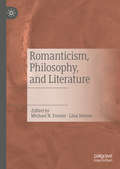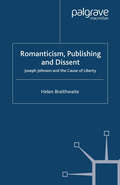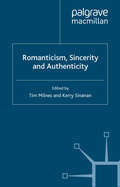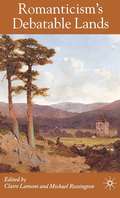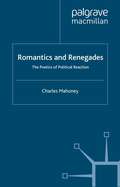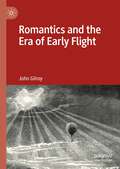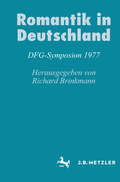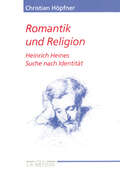- Table View
- List View
Romanticism (Introductions to British Literature and Culture)
by Sharon RustonIntroductions to British Literature and Culture provide practical guides to key literary periods. Guides in the series help to orientate students as they begin a new module or area of study, providing concise information on the historical, cultural, literary and critical context and acting as an initial map of the knowledge needed to study the literature and culture of a specific period. This accessible introduction to Romanticism and its contexts from 1780-1820 includes: - an overview of the historical, cultural and intellectual background including the romantic movement in culture, political upheaval, philosophy and religion and scientific development - a survey of the developments in key genres including discussion of major writers such as Blake, Wordsworth, Coleridge, Keats, Shelley, Byron, Wollstonecraft, Hemans and Smith - concise explanations of key terms needed to understand the literature and criticism - a guide to key critical approaches - a chronology mapping historical events and literary works - guided further reading including websites and electronic resources.
Romanticism, Philosophy, and Literature
by Michael N. Forster Lina SteinerThis book offers a broad re-evaluation of the key ideas developed by the German Romantics concerning philosophy and literature. It focuses not only on their own work, but also on that of their fellow travelers (such as Hölderlin) and their contemporary opponents (such as Hegel), as well as on various reactions to and transpositions of their ideas in later authors, including Coleridge, Byron, Kierkegaard, Nietzsche, and Dostoevsky.
Romanticism, Publishing and Dissent: Joseph Johnson and the Cause of Liberty
by H. BraithwaiteJoseph Johnson (1738-1809) was arguably the foremost bookseller of the late eighteenth century in England, publishing Joseph Priestley, William Cowper, Anna Laetitia Barbauld, Mary Wollstonecroft, Wordsworth and Coleridge, among others, and his output closely linked to the turbulent events of his age. This book seeks to reassess the reputation of a man unfairly condemned in his own time as a dangerously 'radical' publisher and how far the works he published tended to promote the case for religious and political reform.
Romanticism, Rousseau, Switzerland: New Prospects (Palgrave Studies in the Enlightenment, Romanticism and Cultures of Print)
by Angela EsterhammerThis collection brings together current research on topics that are perennially important to Romantic studies: the life and work of Jean-Jacques Rousseau, and the landscape and history of his native Switzerland.
Romanticism, Sincerity and Authenticity
by Tim Milnes & Kerry SinananThe categories of authenticity and sincerity, treated sceptically since the early twentieth century, remain indispensable for the study of Romantic literature and culture. This book, focusing on authors including Wordsworth, Macpherson and Austen, highlights their complexities, showing how they can become meaningful to current critical debates.
Romanticism's Debatable Lands
by C. Lamont M. RossingtonThis book uses the theme of 'debatable lands', to explore aspects of writing in the Romantic period. Walter Scott brought it to a wider public, and the phrase came to be applied to debates which were intellectual, political or artistic. These debates are pursued in a collection of essays grouped under the headings such as 'Britain and Ireland'.
The Romantics (Routledge Library Editions: Romanticism)
by Stephen PrickettFirst published in 1981. This book aims to show Romanticism as a response to certain questions – in literature, art, religion, philosophy and politics – that were being asked increasingly towards the end of the eighteenth century. The essays focus on growth and change (in society and the individual), nature, feeling and reason, and subjectivism – examining how these questions arose, why they were felt to be important and the kinds of answers that, consciously or unconsciously, the Romantics provided. This title will be of interest to students of literature, history and philosophy.
The Romantics (Routledge Library Editions: Romanticism)
by Stephen PrickettFirst published in 1981. This book aims to show Romanticism as a response to certain questions – in literature, art, religion, philosophy and politics – that were being asked increasingly towards the end of the eighteenth century. The essays focus on growth and change (in society and the individual), nature, feeling and reason, and subjectivism – examining how these questions arose, why they were felt to be important and the kinds of answers that, consciously or unconsciously, the Romantics provided. This title will be of interest to students of literature, history and philosophy.
Romantics and Renegades: The Poetics of Political Reaction
by C. MahoneyRomantics and Renegades examines the abiding crux of romantic criticism: the political apostasies of the Lake poets (Wordsworth, Coleridge, and Southey) as they renounced the revolutionary Jacobinism of their youth in the 1790s in order to claim the high ground of Regency Toryism in the 1810s. Central to this scandal is the figure of William Hazlitt, the literary critic who policed their betrayals in his vigilant exposure of their political and poetical inconsistencies. Mahoney's analysis provides new insight into this abiding critical riddle through close historical and figural readings of the rhetoric of romantic apostasy.
Romantics and the Era of Early Flight
by John GilroyThis book explores the significance of flight to Romantic literature. Although the Romantic movement and the age of ballooning coincided, there has been a curious and long-time tendency to forget that flight was not impossible during this period. This study details the importance of this new technology to Romantic authors, primarily English Romantic poets. It combines accounts of the exploits and experiences of early balloonists with references to Romantic texts, using ballooning lore to illuminate a range of Romantic writings. The balloonists are seen as not just supplying these writers with a new code of metaphors, but as colleagues engaged in similarly imaginative enterprises. The book uncovers an ‘aerial imagination’ shared by a large number of writers in the Romantic period that has its origins in the balloon adventures of the 1780s and following two decades. It will appeal to scholars and students of Romantic cultural history, as well as those interested in Romantic poetry and the history of early aeronautics.
The Romantics and the May Day Tradition
by Essaka JoshuaThis important contribution to both Romantic and cultural studies situates literature by Wordsworth, Southey, Hunt, Clare, and Blake within the context of folklore and popular customs associated with May Day. Romantic responses to May Day bring into focus a range of issues now regarded as central to the writing of the period - the natural world, city life, the pastoral, regional and national identities, popular culture, cultural degeneration, and cultural difference. Essaka Joshua explores new connections between these issues in the context of a set of heterogeneous cultural practices that are rooted in the traditions and activities of diverse social groups. She shows how Romantic writers have positioned themselves in relation to what has become known as the public sphere, and the way in which they articulate an understanding of the common sphere as a site of plebeian self-expression. Joshua's nuanced account acknowledges the full complexity of class formations and inter-class relationships and permits noncanonical and canonical texts such as the Prelude, Songs of Innocence and Experience, and 'The Village Minstrel' to be reinterpreted in a cultural context that has not been previously explored by literary critics.
The Romantics and the May Day Tradition
by Essaka JoshuaThis important contribution to both Romantic and cultural studies situates literature by Wordsworth, Southey, Hunt, Clare, and Blake within the context of folklore and popular customs associated with May Day. Romantic responses to May Day bring into focus a range of issues now regarded as central to the writing of the period - the natural world, city life, the pastoral, regional and national identities, popular culture, cultural degeneration, and cultural difference. Essaka Joshua explores new connections between these issues in the context of a set of heterogeneous cultural practices that are rooted in the traditions and activities of diverse social groups. She shows how Romantic writers have positioned themselves in relation to what has become known as the public sphere, and the way in which they articulate an understanding of the common sphere as a site of plebeian self-expression. Joshua's nuanced account acknowledges the full complexity of class formations and inter-class relationships and permits noncanonical and canonical texts such as the Prelude, Songs of Innocence and Experience, and 'The Village Minstrel' to be reinterpreted in a cultural context that has not been previously explored by literary critics.
A Romantics Chronology, 1780-1832 (Author Chronologies Series)
by Martin GarrettThis book covers the life and work of a wide range of writers from Coleridge to Wollstonecraft, Hemans, Beckford and their contemporaries. Also encompassing a wealth of material on contexts from the treason trials of 1794 to the coming of gas-light to the London stage in 1817, it provides a panorama of one of the richest periods in British culture.
The Romantics Reviewed: Contemporary Reviews of British Romantic Writers
by Donald ReimanFirst published in 1972, this set of 9 volumes contains all contemporary British periodical reviews of the first (or other significantly early) editions from 1793 and 1824 of works by William Wordsworth, Samuel Taylor Coleridge, George Gordon Byron, Percy Bysshe Shelley, and John Keats. In addition, a few later reviews are supplied, as well as a substantial number of reviews of other contemporary figures, including William Godwin, Robert Southey, Samuel Rogers, Thomas Campbell, Thomas Moore, Leigh Hunt, William Hazlitt, and Mary Wollstonecraft Shelley.Introductions to each periodical provide brief sketches of each publication as well as names, dates and bibliographical information. Headnotes offer bibliographical data of the reviews and suggested approaches to studying them. The index serves to locate authors and titles reviewed, reviewers, sources of quotations, other people and works mentioned and other proper nouns of interest. This comprehensive set will be of interest to those studying the Romantics and English literature.
Romantiere: Zoopoetik bei Wieland und Wezel (Cultural Animal Studies #10)
by Adrian RobanusDiese literaturwissenschaftliche Studie befasst sich mit Konzeptionen des Tiers in der Spätaufklärung. In der Anthropologie des 18. Jahrhunderts sind Tiere wichtige Grenzfiguren. Das gilt sowohl für ‚das Tier‘ als abstrakte Kategorie als auch für konkrete Tiere – am prominentesten den Affen. Auch im politischen Denken der Aufklärung tauchen häufig tierliche Reflexionsfiguren auf, etwa Wölfe oder Löwen. Die Arbeit erforscht, wie zeitgenössische Romane von Wieland und Wezel aus diesen Tierfigurationen eine Zoopoetik entwickeln. Der spezifische ‚Gebrauch‘ der Romantiere in den untersuchten Texten macht die Funktion von Tierkonzeptionen für Anthropologie und Politik des 18. Jahrhunderts besser verstehbar.
Romantik: Lehrbuch Germanistik
by Detlef KremerDieses Lehrbuch informiert umfassende über die Literatur der deutschen Romantik von der Frühromantik bis zu den Ausläufern der Spätromantik um 1830/40. Der Autor versteht die deutsche Romantik als eine literarische Revolution, von der entscheidende Impulse für eine literarische Moderne in ganz Europa ausgehen. Der Band skizziert die kultur- bzw. sozialgeschichtlichen sowie die philosophischen und wissenschaftlichen Kontexte der Romantik sowie die romantische Poetik und Ästhetik. Den Hauptteil bildet die ausführliche Darstellung zentraler Werke der verschiedenen Gattungen. Für die 4. Auflage wurde der Band durchgesehen und insbesondere bibliographisch aktualisiert.
Romantik: Lehrbuch Germanistik
by Detlef KremerStandard-Lehrbuch für Schule und Universität. Die deutsche Romantik gilt als Impulsgeber der europäischen Moderne. Deshalb gehört diese Epoche zu den Schwerpunktthemen im Unterricht. Was kennzeichnet die Romantik gegenüber Aufklärung, Klassik, Biedermeier und Realismus? Was schrieben E.T.A. Hoffmann, Achim von Arnim, Josef von Eichendorff oder Ludwig Tieck? Und wie sind ihre Werke zu interpretieren? Auf neuestem Forschungsstand geht die 3. Auflage den zentralen Fragen auf den Grund.
Romantik: Lehrbuch Germanistik
by Detlef KremerDie deutsche Romantik eine literarische Revolution? Unstrittig ist, dass die Ära von der Jahrhundertwende bis 1840 die Moderne ganz in Europa maßgeblich inspiriert hat. Ausgehend vom kultur- und sozialgeschichtlichen Kontext wird die Epoche von Aufklärung, Klassik, Biedermeier, Junges Deutschland und Realismus abgegrenzt. Im Mittelpunkt stehen vor allem Epik, Drama und Lyrik. Natur-, Sprach- und Geschichtsphilosophie, romantische Psychologie werden ebenso erörtert wie die romantische Poetik und Ästhetik. Ein bewährtes Lehrbuch zu einem zentralen Thema in Deutschunterricht und Germanistikstudium.
Romantik: Lehrbuch Germanistik
by Detlef KremerDieser Band bietet eine umfassende Einführung in die Literatur der deutschen Romantik.
Romantik in Deutschland: DFG-Symposion 1977 (Germanistische Symposien)
Ihrem universalistischen Denken selbst entsprechend bewegt sich die Epoche der Romantik im Spannungsfeld von Kunst, Ästhetik und Wirklichkeit; Kunstglauben, Mythologie und Theologie; von Naturgefühl, Naturwissenschaft und Naturphilosophie. Der vorliegdne Band unternimmt den Versuch einer Synthese der Forschungsansätze unterschiedlichster Disziplinen: Literaturwissenschaften, Naturwissenschaften und Medizin, Geschichtswissenschaften, Philosophie, Theologie, Kunst- und Musikwissenschaft.
Romantik und Religion: Heinrich Heines Suche nach Identität. Heine-Studien (Heine Studien)
by Christian HöpfnerHöpfners Arbeit geht der existentiellen Bedeutung der beiden Bereiche Romantik und Religion nach. Sie zeigt, wie Heine als Mensch des 19. Jahrhunderts nach beruflicher und religiöser Identität moderne Antworten findet. Heinrich Heine, ein Außenseiter auf der Suche nach seiner Identität: Als Jude von der deutschen Gesellschaft nicht aufgenommen, in bürgerlichen Berufen gescheitert, als Dichter von Zensur und zeitgenössischer Kritik erbarmungslos verfolgt.
Romantische Ökologien: Vielfältige Naturen um 1800 (Neue Romantikforschung #4)
by Roland Borgards Frederike Middelhoff Barbara ThumsDer Band widmet sich der Frage, wie sich europäische Romantiken im Zeitraum zwischen ca. 1790 und 1850 mit ökologischen Theoremen und umweltbezogenen Problembereichen auseinandersetzen. Die Aufsätze dieses interdisziplinären Sammelbandes untersuchen dabei insbesondere den spezifischen Beitrag, den die Künste bei der Ausgestaltung und Formierung eines modernen ökologischen Denkens leisten, das seit Ende des 18. Jahrhunderts Gestalt annimmt, in den 1860er Jahren mit Ernst Haeckels Definition der ‚Ökologie‘ terminologisch grundiert wird und bis heute unser Verständnis von ökologischen Zusammenhängen prägt. Der Band bereichert auf diese Weise die bereits lebendige Forschungslandschaft der Environmental Humanities im Allgemeinen, des Romantic Ecocriticism im Speziellen und fragt mit Blick auf die ‚Romantischen Ökologien‘ nicht nur nach der Diversität und den konfliktreichen Bruchlinien ökologischer Denkformen um 1800, sondern auch nach dem Stellenwert, dem Eigen- und möglicherweise Mehrwert des Ästhetischen sowie, damit verknüpft, nach der Rolle des Romantischen für die Entstehung, Reflexion und Transformation eines ökologischen Denkens.
Romantischer Realismus: Literarhistorische Kontinuität im 19. Jahrhundert (Abhandlungen zur Literaturwissenschaft)
by Christoph GardianRomantik und Realismus werden in der Literaturgeschichtsschreibung vorwiegend als Gegensätze beschrieben. Ihre Rekonstruktion als dichotome Epochen verstellt aber den Blick auf die Kontinuitäten zwischen den beiden großen Literaturbewegungen des 19. Jahrhunderts, auf ihre gemeinsamen Problemfelder und Strategien zur Problembewältigung. Denn weshalb beziehen sich Texte in der zweiten Hälfte des 19. Jahrhunderts permanent auf eine Literatur, die sie als ›Romantik‹ kennzeichnen und aus der Welt schaffen wollen? Weshalb bearbeiten Texte, die als ›realistische‹ positioniert werden, über einen Zeitraum von immerhin gut 50 Jahren Konzepte und Themenkomplexe, die erkennbar ihren Anfang in der von ihnen abgelehnten und als obsolet konzipierten Romantik nehmen? Weshalb lassen sie fortwährend romantische Figuren auftreten oder romantische Motive handlungsleitend ein? Ganz offenbar handelt es sich beim Romantischen, das der Realismus bestreitet, um einen unerledigten Problemkomplex. Ausgehend vondiesen Beobachtungen stellt sich das Verhältnis von romantischer und realistischer Literatur weniger als epochale Dichotomie, sondern vielmehr als konstitutives Wechselverhältnis dar – als komplementäre Konstellation vor einem gemeinsamen Problemhorizont. Romantische und realistische Literatur lassen sich als alternative und gleichwohl parallele Strategien im Umgang mit historischen Transformationsprozessen auffassen, die ungeachtet ihrer markierten Konkurrenz kaum jemals ungemischt zur Anwendung kommen. Romantische und realistische Tendenzen treten in wechselseitiger Abhängigkeit auf. Dabei geht es sowohl den programmatisch romantisierenden als auch den programmatisch realistischen Texten um nicht weniger als die Gestaltung gesellschaftlicher Realität. Auf der Grundlage einer anderen Begründungsgeschichte der deutschsprachigen Literatur im 19. Jahrhundert lassen sich Beschreibungsmodelle für kulturelle Identifikations- und Transformationsprozesse gewinnen. Die untersuchten literarischen Texte formulieren ebenso Konzepte für den Umgang mit kulturellem Wandel wie sie Konstellationen kulturellen Wandels als Positionskämpfe zwischen romantischen und realistischen Akteuren konfigurieren.
Rome Against Caratacus: The Roman Campaigns in Britain AD 48-58
by Graham WebsterThe Roman Conquest of Britain in AD 43 was one of the most important turning points in the history of the British Isles. It left a legacy still discernible today in the form of archaeological remain, road networks, land divisions and even language.In his much-acclaimed trilogy, now up-dated and revised, Dr Webster builds up a fascinating and lively picture of Britain in the first century AD and discussed in detail the various types of evidence and the theories based upon it.Caratacus' last stand against the Romans has a central place in the folklore of the Welsh Marches, where many a hill is claimed to be the site of the famous battle. But, as Graham Webster shows, this epic encounter was not only real history but also part of an intricate ten-year series of campaigns conducted after the initial conquest of Britain.By interpreting the ancient historical accounts and piecing together the masses of archaeological evidence, Dr Webster has brilliantly reconstructed this central period of the Claudian Conquest of Britain and its immediate aftermath.

